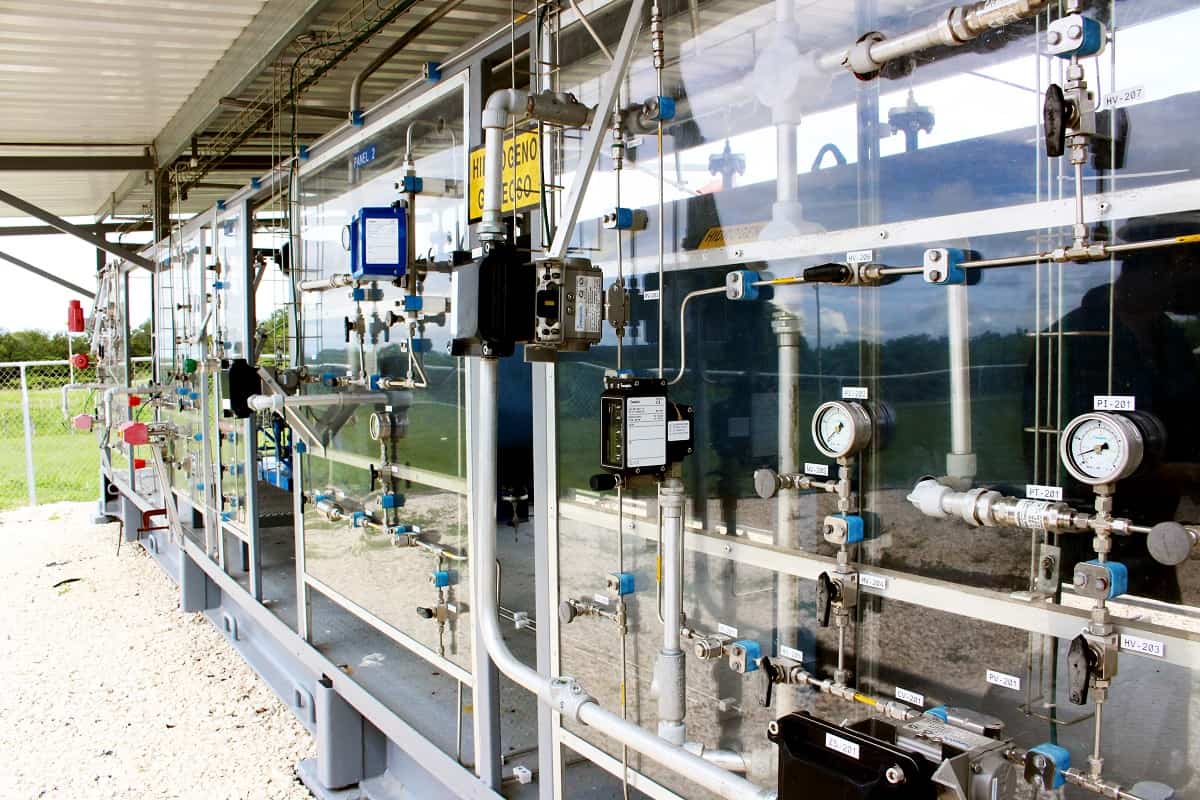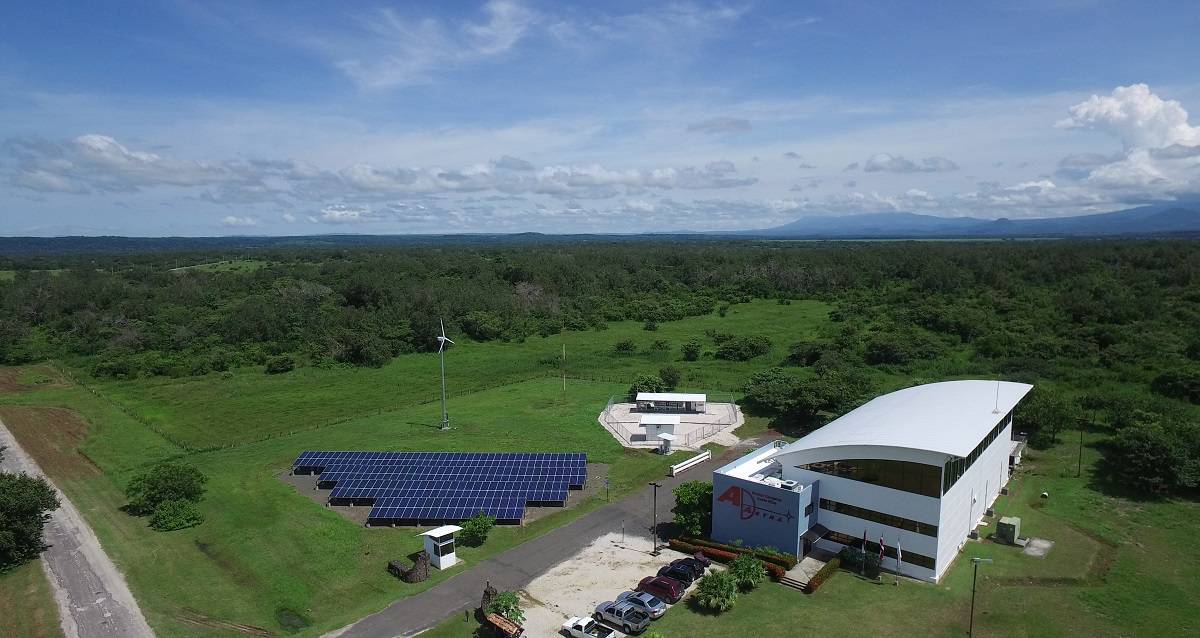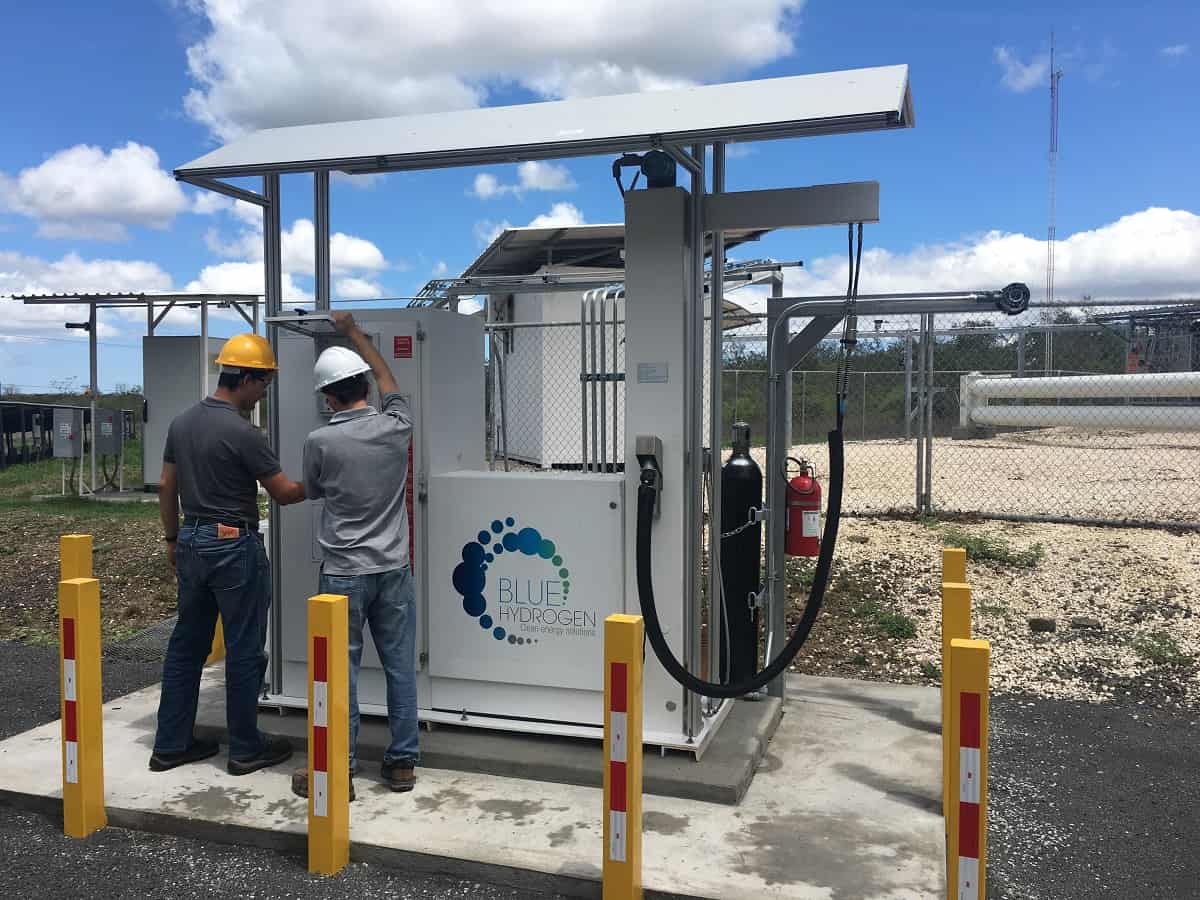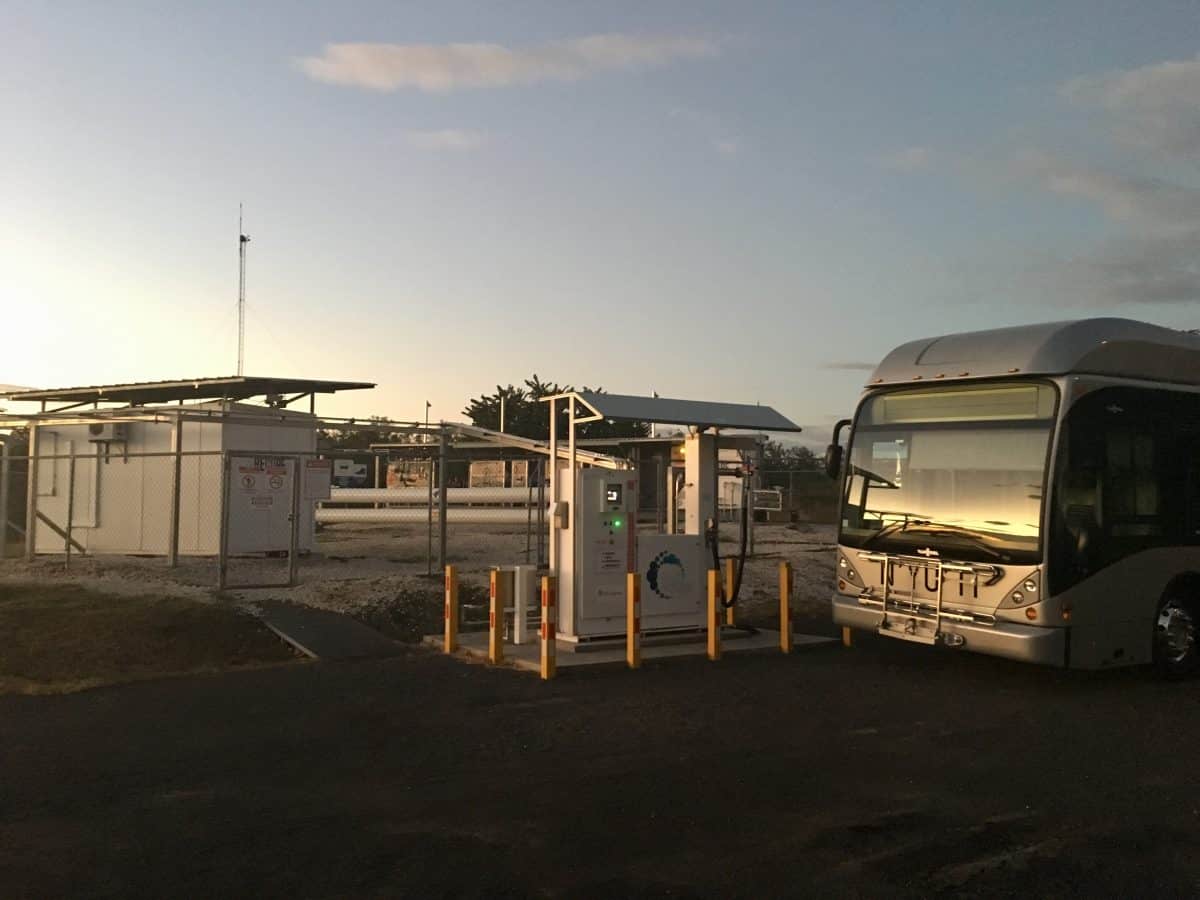GUANACASTE – Just off a quiet road amid sparsely wooded fields are four rows of solar panels and a single wind turbine. The power they generate is sent a few feet away to a small-scale hydrogen production and storage plant, a cluster of structures and tanks surrounded by a chain-link fence. Next to that is a sleek digital dispenser with a gas-station style hose to deliver the compressed hydrogen to a vehicle.
Specifically, it’s a boxy 35-passenger bus called “Nyuti” (which means “star” in the local Chorotega indigenous language) that sits in the adjacent parking lot. This is Central America’s first hydrogen transportation “ecosystem” and, seven years after the effort to introduce hydrogen fuel cell vehicles in Costa Rica began, Nyuti is taking to the road.
The project is led by Ad Astra Rocket Company, which operates in Houston and Costa Rica. Ad Astra isn’t developing hydrogen technologies, but working with several partners to integrate them in Costa Rica. The aerospace company, founded by former NASA astronaut and Costa Rican native Franklin Chang Díaz, added hydrogen technology to its repertoire in hopes of addressing the greatest obstacle to Costa Rica’s goal of carbon neutrality: transportation.
NASA selects Franklin Chang’s Ad Astra Rocket for $50 million contract
Transportation key to solving energy challenge
The country’s electric grid is powered almost entirely by renewables: its abundant rainfall and rivers allow for hydro power to meet the bulk of the electricity demand, followed by geothermal, wind, biomass and solar. But the nation’s famously green grid accounts for only about 30 percent of its total energy consumption. The other 70 percent is consumed by the highly polluting transportation sector.
“We know the country has a really large energy problem that has to be solved in transportation,” Juan Del Valle, director of operations at Ad Astra Rocket Company Costa Rica, said in a phone interview.
Costa Rica’s urban Central Valley, home to more than half of the country’s 4.9 million people, is “extremely crowded and the transportation infrastructure is underdeveloped and unreliable,” Del Valle said, pointing to the antiquated and oft-criticized public transportation system as a major problem.
Nyuti is doing test runs between its home base at Ad Astra and a nearby airport. But making the technology work is only the first phase of implementation; Ad Astra now has to determine whether it’s technically and economically feasible to scale up the operation.
While Ad Astra has been developing its hydrogen ecosystem, battery electric vehicles (BEV) have begun to take hold in the country, which has some 20 operational charging stations so far. Increasing public awareness and support for electric transportation helped bring about the recent passage of an “incentives law” that promotes electric transportation by, among other things, suspending import taxes on zero-emission vehicles.

Lawmaker Marcela Guerrero Campos, who proposed the law, told Yale Climate Connections it’s designed to stimulate both supply and demand of all zero-emission vehicles, with a particular focus on BEVs. She said Costa Rica should support the hydrogen project, but for now the infrastructure is too expensive to build.
But Del Valle believes that just as BEVs can meet the immediate need for carbon-free personal vehicles, hydrogen technologies have a complimentary role to play in the long run.
“We believe hydrogen vehicles are especially suited for public transportation or heavy-duty trucks or any type of vehicle that has to be constantly on the move,” such as garbage trucks or cargo vehicles, Del Valle said.
“Eventually,” he added, “hydrogen will play an important role as a means of clean storage of energy so we could use it to expand production of local renewables.”
Inside a fuel cell: extracting electrons
Like BEVs, hydrogen fuel cell vehicles (HFCV) have an electric motor and don’t produce harmful emissions. But rather than powering the motor with energy stored in a battery, HFCVs use hydrogen to produce electricity with a fuel cell stack in the vehicle’s powertrain.
The type that powers Nyuti is called a proton exchange membrane fuel cell. Each cell has an electrolyte membrane sandwiched between an anode and a cathode. The H2 molecules are sent to the anode, and oxygen from the ambient air is sent to the cathode. The hydrogen is attracted to the oxygen on the other side of the cell, but can only cross the electrolyte membrane if it sheds its electrons. The anode helps split the H2 molecules apart, and the released electrons flow away through a circuit, forming an electrical current that powers the engine and on-board devices like the radio and air conditioning. The remaining hydrogen ions (protons) are then free to pass through the membrane. When they reach the cathode, they join with electrons returning to the cell on the other end of the circuit, and the oxygen molecules, to form water, the vehicles’ only emission. (Watch a video of the process.)

HFCVs are cleaner and more efficient than combustion engines, and have an edge over BEVs in terms of both weight and filling time.
“Battery electric vehicles do have their limit as in how heavy a vehicle they can power,” said Scott Samuelsen, director of the National Fuel Cell Research Center at the University of California, Irvine, in a phone interview. “You get to a point where to put batteries on board to power a heavy-duty vehicle you add so much weight it’s a point of no return.”
Hydrogen is light, and filling a vehicle’s hydrogen tank takes only a few minutes, as opposed to hours of charging time. This combination makes it an appealing option for heavy vehicles operating on a closed circuit and for those that can’t be removed from service for long periods.
‘Not even carbon-neutral’… completely carbon free
The main obstacle to advancing HFCVs lies in producing hydrogen efficiently and without using so much fossil fuel that it negates the benefit of an electric engine. It’s commonly made by steam reforming natural gas; Ad Astra instead is using electricity from its solar farm and wind turbine to power electrolysis.
“The whole idea of doing this,” Del Valle said, “is that the whole process is not [just] carbon-neutral, but it’s completely carbon-free.”
In the plant, electricity is combined with water, splitting the water molecules apart. The oxygen is released into the air, and the hydrogen is compressed and stored in tanks. Inside the fuel cell, the reverse process takes place: whereas electrolysis uses electricity and water to make hydrogen, a fuel cell uses that hydrogen to make electricity and water.

Nyuti has the same range as a conventional bus, Del Valle says, about 220 miles per fill of hydrogen, but Ad Astra’s plant can produce only enough hydrogen for short, intermittent trips.
The other major obstacle to deploying HFCVs, Samuelsen says, involves setting up hydrogen fueling stations to support the initial deployment of HFCVs.
“One problem with hydrogen technologies is it makes no sense to bring the vehicles if you don’t have the infrastructure,” Del Valle said, “and the opposite is also true: it makes no sense to create infrastructure if you have no vehicles.”
A long-term solution?
Ad Astra’s hydrogen project began as a collaboration with Costa Rica’s state-owned oil refinery in 2011, but that partnership ended in 2014 after concerns were raised about the legality of the refinery’s involvement with non-petroleum fuels.
After temporarily halting the project, Ad Astra in 2016 found a new government partner in the Development Bank System (SBD), which funds small businesses. The project has since become a public-private partnership between Ad Astra, SBD, and international companies including Cummins, Inc.; Air Liquide; US Hybrid Corporation; and Relaxury S.A., a subsidiary of the Costa Rican Toyota distributor.
About $4.4 million has been invested so far, just over half of which came from Ad Astra and its private sector partners. Del Valle says there has been only a small amount of political resistance to the project, which he chalks up to resistance to new ways of doing things.
“Some politicians are not used to the concept of public money being used to develop things through private partners,” Del Valle said, “and that’s part of the change we’re trying to bring.”
Miguel Aguiar, executive director of SBD, told Yale Climate Connections the organization is prepared to continue funding the project in phases, to be defined as the group progresses. Having completed the proof-of-concept phase with the demonstration of Nyuti, Ad Astra next will move to scale up its hydrogen production and bring in additional vehicles. Del Valle says they would like to see fuel cell buses providing transportation between the nearby airport and the province’s popular beaches and resorts.
In addition to transportation, Del Valle sees the potential for hydrogen to serve as a form of energy storage for intermittent energy sources like wind and solar. Since hydropower dams can harm ecosystems, and most geothermal sources are located inside national parks, both face some opposition in Costa Rica. Del Valle believes that will lead to greater reliance on solar and wind – intermittent sources whose “extra” power could be used to produce hydrogen when energy supply exceeds demand.
Despite the seemingly long road ahead for the hydrogen effort in Costa Rica, Gordon Abas Goodarzi, President and CEO of US Hybrid Corporation, which provided the bus for the project, says he is in no rush to see results.
“We’re not pushing any timeline,” Goodarzi said in a phone interview, but pointed out that the Costa Rican team deployed the vehicle in record time as compared to other places the company has helped implement HFCVs, like China and Hawaii.
Goodarzi said authorities in Costa Rica seem especially supportive of the project, but that its fate ultimately will come down to economics, financial viability, and politics.
“We have to deploy and let the market and customers decide,” he said.
For his part, Del Valle knows that in addition to technical challenges that lie ahead, the cost of hydrogen technologies must come down for them to be a viable option. And when they do, he said, “we’ll be ready.”
Originally published by Yale Climate Connections and republished by permission. Robin Kazmier is a Boston-based science reporter and former Tico Times staff member. She is author of “National Parks of Costa Rica” and was the editor of The Tico Times’ two published books, “The Green Season” and “Love in Translation.”

